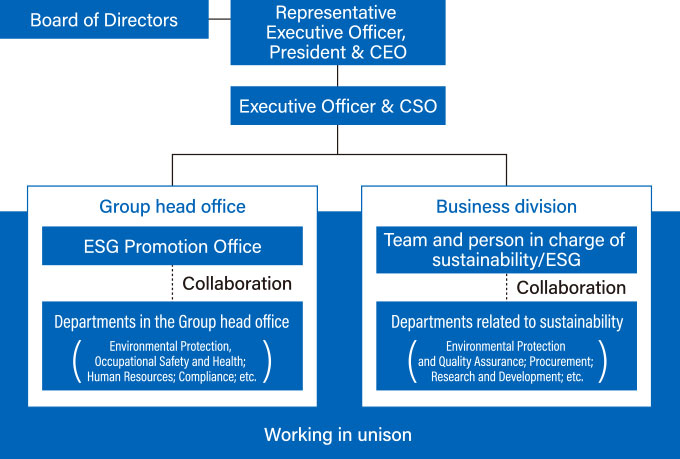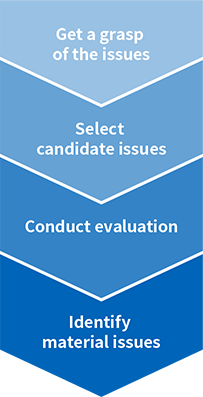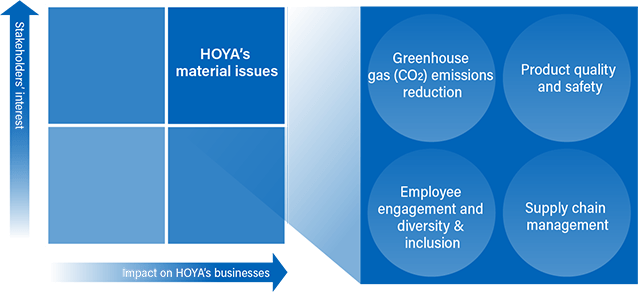HOYA’s ESG Approach
ESG and Sustainability Governance Framework
Governance
HOYA is organized as a company with Nomination Committee, etc. As such, the Board of Directors functions as a monitoring board, supervising the executive side and deliberating and deciding on materialities in management policy Group-wide. To secure management supervisory functions and ensure their objectivity, in fiscal 2022 the Company established a framework in which six of eight directors are outside directors. All outside directors are fully experienced as managers and possess an international outlook; moreover, three of the six outside directors were selected in part for having backgrounds in personnel training and diversity. Some of the outside directors have experience in key management decision-making regarding climate change.
The ESG Promotion Office proposes basic policy, materialities, and key measures such as TCFD and RE100 concerning the Group’s sustainability. The Board of Directors deliberates on these proposed measures and decides whether to adopt them. In addition, the Board of Directors receives regular reports on issues related to sustainability, including responses to climate change, from the Chief Sustainability (ESG) Officer (four times in fiscal 2022). The Board offers advice from multifaceted perspectives. Similarly, the Group CHRO reports regularly to the Board of Directors regarding personnel measures across the HOYA Group.
At HOYA, we conduct business operations through a divisional management approach facilitated by portfolio management. As such, each business division’s specific policies on responding to sustainability-related issues, including climate change and human capital, are reflected in the management strategy, management plan and annual budget of each business, to be approved and decided by the Board of Directors. Each business division has assigned a team in charge of sustainability/ESG, which confers with the CSO to set targets and KPIs for that business division in line with Group targets. The CSO reports the activities and progress of each business division to the Board of Directors, which monitors said activities and progress.
In fiscal 2022, ESG indicators were incorporated into the Performance Share Unit (PSU), serving as a medium- to long-term incentive in Executive Officer’s remuneration. Targets are set according to evaluations by outside organizations and the status of efforts on key ESG themes. In fiscal 2023, to enhance the effectiveness of these indicators, important KPIs among the key ESG-related targets set by each business division, such as renewable-energy usage rate, were added to the criteria for annual incentives of the presidents of each business division.
Risk Management
The HOYA Group’s head office appoints persons responsible for functions considered a significant risk to the Company, including compliance, response to pharmaceutical regulations, cybersecurity and safety/hygiene. The responsible persons in the head office cooperate with persons responsible for the same functions in each business division to identify and prevent risks and submit a report once a year to the Board of Directors. With respect to climate change, the head-office TCFD project and business divisions draft and implement response measures appropriate to each business division, based on TCFD scenario analysis. (In fiscal 2022, analysis was conducted on the eyeglass lens business and the HDD glass substrate business.)

Sustainability Policy
For the purpose of clearly stipulating the HOYA Group’s basic stance and policy on sustainability and further promoting sustainability activities, we established the HOYA Group’s Sustainability Policy in May 2022.
HOYA Group is committed to contribute towards building a sustainable society and aims to enhance our long-term corporate value by implementing our management principles based on our corporate mission in our day-to-day work.
We will aim to help resolve global social issues through innovation in our businesses.
We will realize fair and highly transparent corporate management by building a relationship based on trust through consistent dialogue with key stakeholders.
We will aim to minimize environmental externalities in our business activities to ensure our future generations inherit a healthy global environment in future.
We respect the human rights of all people involved in our business activities, including those in our supply chain and will strive to prevent any abuse on human rights.
We will create a work environment to promote diversity and inclusion with an emphasis on the wellbeing of our employees in the aim of keeping high motivation and moral to create new value.
For HOYA’s Corporate Mission, Management Principles and Vision, click here.
Material Issues
Having internally discussed and examined matters that contribute to the HOYA Group’s medium- to long-term growth (i.e., material issues), we identified four material issues with the approval of the Board of Directors in September 2021.
Process of Identifying Material Issues

Get a grasp of changes in society and issues related to HOYA’s businesses.
Analyze ESG rating agencies’ evaluation of HOYA and refer to international guidelines*1.
Interview the management of business divisions.
Use the industry-by-industry Materiality Map*2 by SASB*3 that matches HOYA’s businesses and select the candidate issues based on evaluation on two axes, i.e., by mapping stakeholders’ interest on the vertical axis and the impact on HOYA’s businesses on the horizontal axis.
Conduct an evaluation comprehensively by deepening internal discussions while referring to opinions and feedback obtained from investors in and outside Japan who are key stakeholders.
Obtain approval for the identified four material issues at the Board of Directors’ meeting.
*1. SASB, GRI, IIRC, ISO26000, TCFD, RBA, CDP
*2. Industries: Medical Equipment & Supplies, Hardware, Semiconductors
*3. Sustainability Accounting Standards Board
Identified Material Issues
Four material issues have been identified in HOYA as a result of the above process.

Risks and Opportunities of Material Issues
In consideration of the social issues worldwide and HOYA’s business environment, we examined and discussed the following risks and opportunities in the process of selecting material issues.
Material issue |
Risk |
Opportunity |
|---|---|---|
Greenhouse gas (CO2) emissions reduction |
|
|
Product quality and safety |
|
|
Employee engagement and diversity & inclusion |
|
|
Supply chain management |
|
|
Approach to and Measures for Material Issues
Material issue |
Approach |
Measures |
Relevant SDGs |
|---|---|---|---|
Greenhouse gas (CO2) emissions reduction |
Set a medium- and long-term target for CO2 emissions reduction and create a roadmap to achieve it |
|
|
Product quality and safety |
Review and improve the product safety and quality management system and operations on an ongoing basis?especially in the Life Care business, which deals in medical products?so that customers can use products more effectively and safely |
|
|
Employee engagement and diversity & inclusion |
Aim at creating a workplace environment in which diverse employees can fully demonstrate their capabilities with a sense of fulfillment from work so that employees’ growth also translates into HOYA’s growth |
|
|
Supply chain management |
Properly manage the supply chain based on the HOYA Supplier Code of Conduct, from the viewpoint of complying with laws and regulations and protecting human rights not only internally but also in the supply chain |
|
|
・Measures and targets/indexes for material issues will be additionally set and reviewed in the process of holding discussions and carrying out initiatives in-house.
・As HOYA’s businesses are wide-ranging, we will also discuss and examine individual sustainability/ESG issues in each business division on top of the common material issues.
